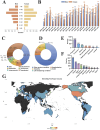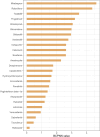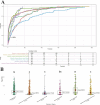Drug-induced retinal vein occlusion: a disproportionality analysis from the FDA adverse event reporting system (2004-2023)
- PMID: 39734405
- PMCID: PMC11671269
- DOI: 10.3389/fphar.2024.1480269
Drug-induced retinal vein occlusion: a disproportionality analysis from the FDA adverse event reporting system (2004-2023)
Abstract
Introduction: Retinal vein occlusion (RVO) often causes irreversible visual impairment, making early prevention crucial. This study aims to identify associations between different medications and RVO and provide information for clinical practice.
Method: This study included reports of RVO from the FDA Adverse Event Reporting System (FAERS) database from the first quarter (Q1) of 2004 to the fourth quarter (Q4) of 2023. The reported drugs were analyzed for adverse drug reaction (ADR) signals using four disproportionality algorithms. Kaplan-Meier curves and median time to onset were used to evaluate the drugs.
Results: From 2004 to 2023, the FAERS database recorded 6,151 reports associated with RVO. Disproportionality analyses identified 25 drugs significantly associated with RVO. Mirabegron showed the highest risk signal, followed by Raloxifene, Tadalafil, Fingolimod, and Bimatoprost. These high-risk drugs are distributed across different therapeutic areas, including urogenital system and sex hormones, ophthalmic drugs, nervous system drugs, musculoskeletal system drugs, anti-tumor and immune-modulating drugs, and anti-parasitic drugs. Specific drug targets such as adrenergic receptor agonists, hormone regulators, and PDE5 inhibitors were identified as high risk. Ophthalmic drugs exhibited the longest median time to adverse ocular reactions at 532.01 days, followed by anti-parasitic drugs, nervous system drugs, urogenital system and sex hormone drugs, anti-tumor and immune-modulating drugs, and musculoskeletal system drugs.
Conclusion: This study provides an overview of drug-induced RVO, identifying potential culprit drugs and their distribution characteristics. These findings enhance understanding of medication safety and help optimize clinical practice.
Keywords: FDA adverse event reporting system; adverse events; disproportionality analysis; pharmacovigilance; retinal vein occlusion.
Copyright © 2024 Chen, Xiao and Zhou.
Conflict of interest statement
The authors declare that the research was conducted in the absence of any commercial or financial relationships that could be construed as a potential conflict of interest.
Figures





Similar articles
-
Adverse events of topical ocular prostaglandin medications for glaucoma treatment: a pharmacovigilance study based on the FAERS database.Ther Adv Drug Saf. 2024 Oct 16;15:20420986241285929. doi: 10.1177/20420986241285929. eCollection 2024. Ther Adv Drug Saf. 2024. PMID: 39429679 Free PMC article.
-
Adverse event profiles of CDK4/6 inhibitors: data mining and disproportionality analysis of the FDA adverse event reporting system.Ther Adv Drug Saf. 2024 Sep 24;15:20420986241278498. doi: 10.1177/20420986241278498. eCollection 2024. Ther Adv Drug Saf. 2024. PMID: 39376495 Free PMC article.
-
Assessing the risk of tumor lysis syndrome associated with the use of antineoplastic agents: a real-world pharmacovigilance study based on the FDA Adverse Event Reporting System database.Ther Adv Drug Saf. 2024 Sep 6;15:20420986241274909. doi: 10.1177/20420986241274909. eCollection 2024. Ther Adv Drug Saf. 2024. PMID: 39247253 Free PMC article.
-
Drug-Induced Acute Pancreatitis: A Real-World Pharmacovigilance Study Using the FDA Adverse Event Reporting System Database.Clin Pharmacol Ther. 2024 Mar;115(3):535-544. doi: 10.1002/cpt.3139. Epub 2024 Jan 2. Clin Pharmacol Ther. 2024. PMID: 38069538 Review.
-
Unraveling the Spectrum of Ocular Toxicity with Oxaliplatin: Clinical Feature Analysis of Cases and Pharmacovigilance Assessment of the US Food and Drug Administration Adverse Event Reporting System Database.Clin Ther. 2024 Dec;46(12):1049-1058. doi: 10.1016/j.clinthera.2024.09.019. Epub 2024 Oct 19. Clin Ther. 2024. PMID: 39428274
Cited by
-
Risk of drug-induced pericardial effusion: a disproportionality analysis of the FAERS database.BMC Pharmacol Toxicol. 2025 Feb 7;26(1):27. doi: 10.1186/s40360-025-00867-6. BMC Pharmacol Toxicol. 2025. PMID: 39920868 Free PMC article.
-
Pharmacovigilance study of drug-induced eye movement disorder based on FDA adverse event reports from 2004 to 2024.Sci Rep. 2025 Jul 1;15(1):21341. doi: 10.1038/s41598-025-05709-3. Sci Rep. 2025. PMID: 40594563 Free PMC article.
-
Pharmacovigilance of drug-induced cataract using the FDA Adverse Event Reporting System.Sci Rep. 2025 Jul 24;15(1):26921. doi: 10.1038/s41598-025-10924-z. Sci Rep. 2025. PMID: 40707607 Free PMC article.
References
LinkOut - more resources
Full Text Sources
Research Materials

